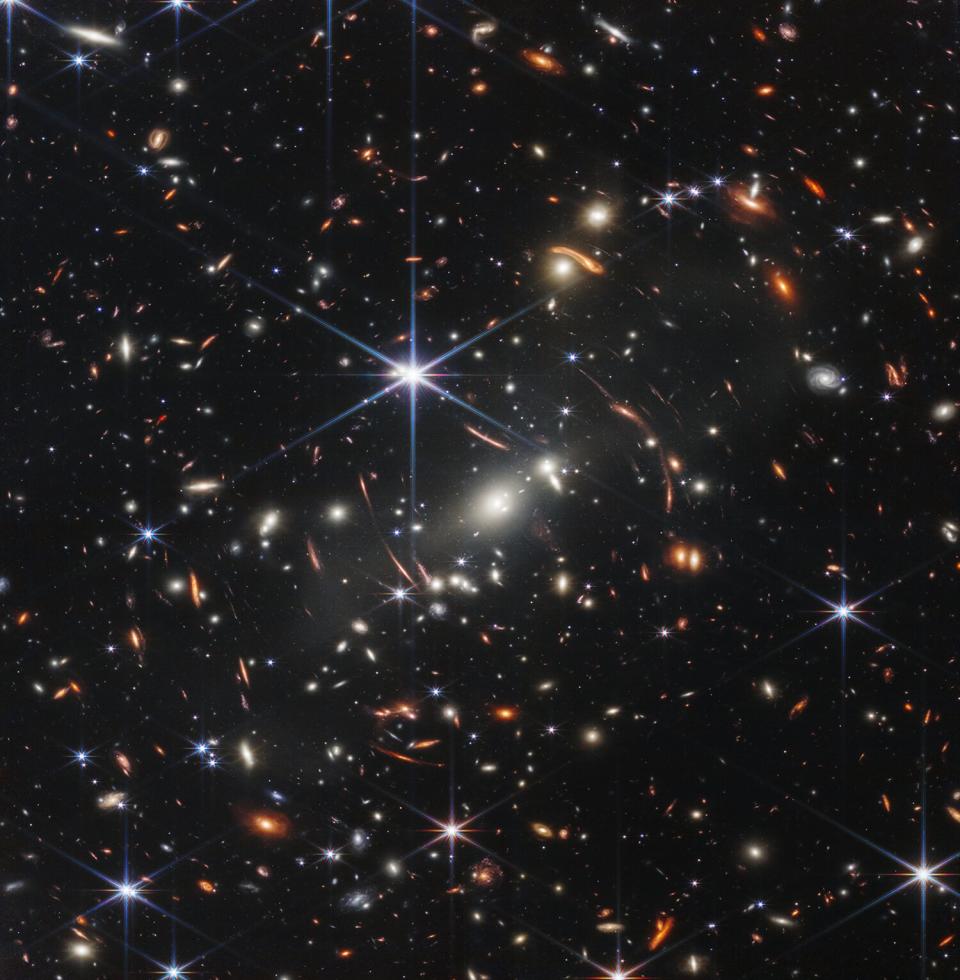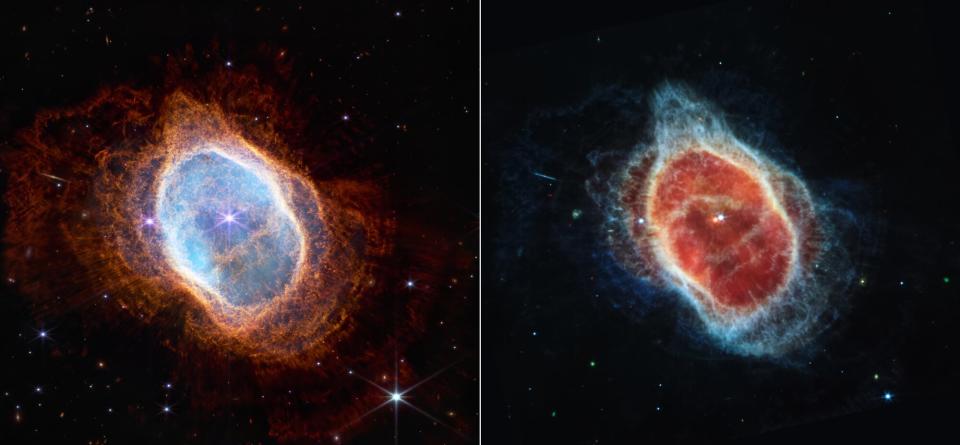NASA Releases First Photos From Webb Space Telescope: 'We Can See Possibilities No One Has Ever Seen Before'

- Oops!Something went wrong.Please try again later.
NASA, ESA, CSA, and STScI via Getty "This landscape of 'mountains' and 'valleys' speckled with glittering stars is actually the edge of a nearby, young, star-forming region called NGC 3324 in the Carina Nebula," NASA said. "Captured in infrared light by NASA’s new James Webb Space Telescope, this image reveals for the first time previously invisible areas of star birth."
The first images of galaxies far, far away, captured by the $10-billion James Webb Space Telescope, have been released.
NASA on Tuesday released images featuring views of a distant galaxy group called Stephan's Quintet, which was discovered in 1877; the Carina Nebula, a stellar nursery; the Southern Ring Nebula; and an exoplanet named WASP-96 b, according to the space agency.
"Every image is a new discovery and each will give humanity a view of the universe that we've never seen before," NASA Administrator Bill Nelson said during an event at the Goddard Space Flight Center to introduce the images.
The new photos came after President Joe Biden on Monday debuted the first full-color photo taken by the telescope, which showcases "the powerful capabilities of the Webb mission, a partnership with ESA (European Space Agency) and CSA (Canadian Space Agency)," according to the space agency.
RELATED: NASA Will Launch Study of UFOs: 'We Are Not Shying Away from Reputational Risk'
"These images are going to remind the world that America can do big things, and remind the American people — especially our children — that there's nothing beyond our capacity," President Biden said. "We can see possibilities no one has ever seen before. We can go places no one has ever gone before."

NASA via Getty "Known as Webb’s First Deep Field, this image of galaxy cluster SMACS 0723 is overflowing with detail," NASA said. "Thousands of galaxies — including the faintest objects ever observed in the infrared — have appeared in Webb’s view for the first time. This slice of the vast universe covers a patch of sky approximately the size of a grain of sand held at arm’s length by someone on the ground."
The first image reveals thousands of galaxies, including the faintest objects ever observed with infrared capabilities, NASA said in a press release.
"Webb's First Deep Field is not only the first full-color image from the James Webb Space Telescope, it's the deepest and sharpest infrared image of the distant universe, so far," Nelson said. "This image covers a patch of sky approximately the size of a grain of sand held at arm's length. It's just a tiny sliver of the vast universe."
RELATED: Inspiration4 Reveal They Felt the 'Overview Effect' in Space — What to Know About the Phenomenon
Taken by Webb's Near-Infrared Camera, the images are made up of different photos taken at different wavelengths of light over the course of 12.5 hours, according to NASA. Its predecessor, the aging Hubble Space Telescope, took weeks to capture image fields.
Webb launched last December on an Ariane 5 rocket from Europe's Spaceport in French Guiana, South America.

NASA, ESA, CSA, and STScI via Getty "The dimmer star at the center of this scene has been sending out rings of gas and dust for thousands of years in all directions, and NASA’s James Webb Space Telescope has revealed for the first time that this star is cloaked in dust," NASA said. "Two cameras aboard Webb captured the latest image of this planetary nebula, cataloged as NGC 3132, and known informally as the Southern Ring Nebula. It is approximately 2,500 light-years away."
Experts have said they are excited about the technology and its capacity to answer long-held questions about the universe.
Never miss a story — sign up for PEOPLE's free daily newsletter to stay up-to-date on the best of what PEOPLE has to offer, from juicy celebrity news to compelling human interest stories.
"Scientists are thrilled that Webb is alive and as powerful as we hoped, far beyond Hubble, and that it survived all hazards to be our golden eye in the sky," John Mather, Webb senior project scientist at NASA's Goddard Space Flight Center in Greenbelt, Maryland, said in the release.
RELATED VIDEO: President Biden Shares First Photo from James Webb Space Telescope — Deepest Infrared Image of Universe Yet
"What happened after the big bang?" Mather added. "How did the expanding universe cool down and make black holes and galaxies and stars and planets and people? Astronomers see everything twice: first with pictures, and then with imagination and calculation. But there's something out there that we've never imagined, and I will be as amazed as you are when we find it."
The full set of the images can be viewed on NASA's website.

